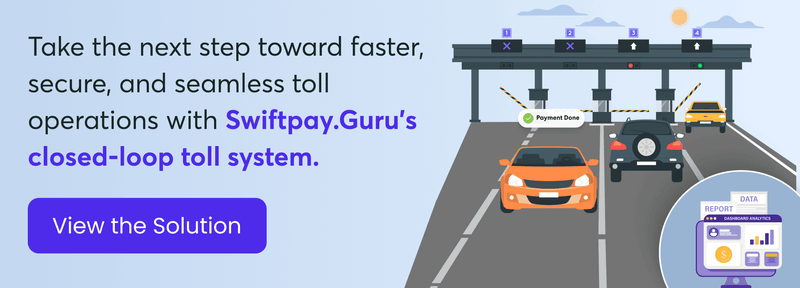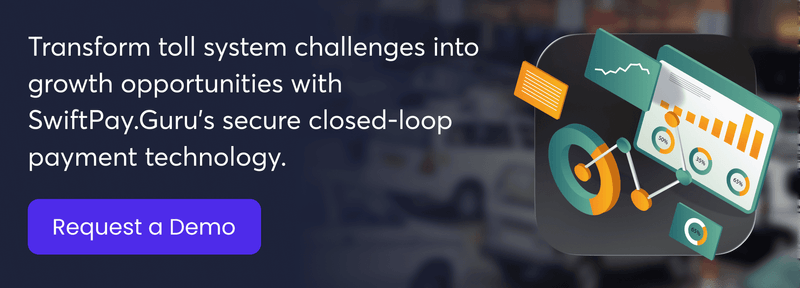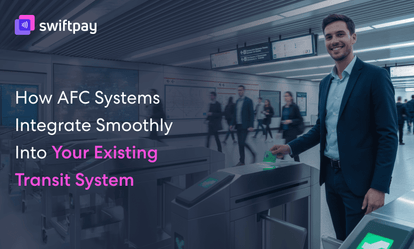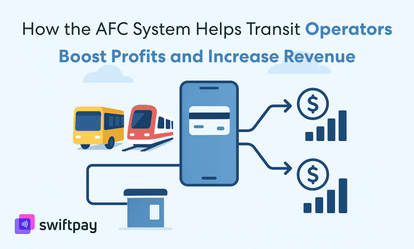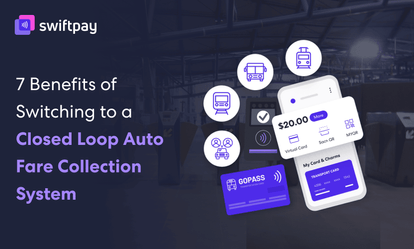A recent KPMG tolling study found that some operators lose nearly 10 to 15 percent of their yearly revenue because of cash handling issues, slow systems, and gaps in collections.
For a toll operator like you, that is a big amount. It decreases your revenue, makes daily work harder, and often leaves your customers and passengers stuck in long queues.
The main reason is clear: Old payment methods like cash payments or traditional systems slow things down, cost more to manage, and leave you with less control over your business. In addition, your staff spends extra hours managing payments, and your customers lose time waiting at the plaza.
This is where a closed-loop toll payment system steps in. It gives you faster payments, better control over your revenue, and a smoother experience for both your staff and your customers.
In this blog, you will see the common challenges that come with setting up a closed-loop toll system, along with simple and practical ways to handle them.
To solve these challenges, you first need a clear picture of what a closed-loop toll payment system means.
Let’s take a closer look.
What Is a Closed-Loop Toll Payment System?
A closed-loop toll payment system is a digital payment solution where your customers use a closed loop e-wallet or a prepaid account that works only within your toll network.
They add money to this wallet, and every time they pass through a toll, the fee is deducted directly from it.
Unlike bank cards or cash, this toll payment system is private to your toll roads, which means you stay in full control of collections and transactions.
Here’s why more operators prefer closed-loop systems today:
- You can keep all payments within your own system, without depending on banks or third parties.
- Your customers can move faster because payments happen instantly in the background.
- You can deal with fewer fraud risks or errors as everything stays in your ecosystem.
- You can save money because there’s less cash handling and fewer manual steps.
In short, a closed-loop toll payment solution gives operators like you more control, more security, and a better experience for your customers.
Next, let’s look at the everyday challenges toll operators deal with and how this system directly solves them.
Common Challenges in Closed-Loop Toll Implementation (and How to Solve Them)
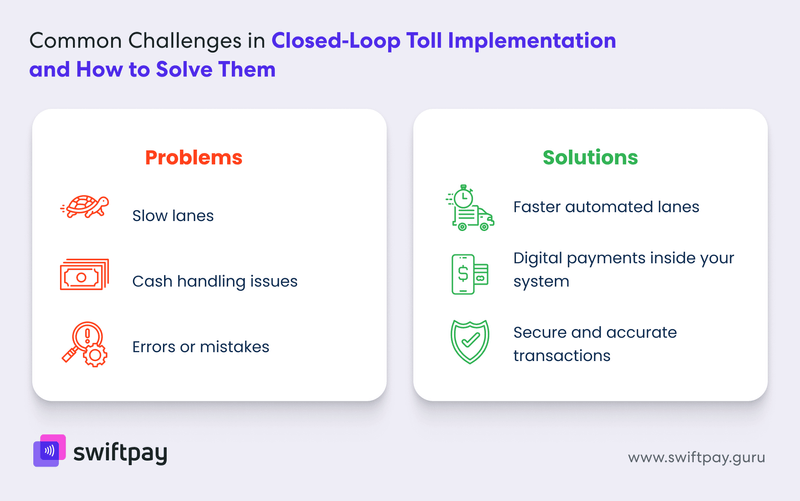
Switching to a closed-loop toll payment system sounds straightforward, but when you get into the details, you realize there are some real-world challenges. The good part is that every challenge has a practical way out.
Let’s walk through the most common challenges and how you, as a toll operator, can handle them.
1. Driver Adoption and Awareness
Problem:
When your customers are used to paying tolls with cash or their existing payment method, they can be hesitant to try something new. Even some worry about downloading another app or learning a different payment method.
Solution:
With a closed-loop toll payment system, you can make adoption easier by simplifying how your customers use it. If the app is user-friendly and sign-up takes only a minute, your customers are more willing to give it a try. However, small rewards like cashback on the first few trips or faster entry lanes for closed-loop users can also help.
Even clear communication at toll plazas, social media updates, and roadside signage builds trust and confidence.
2. Integrating With Existing Infrastructure
Problem:
Closed-loop payments do not run on all toll gates from the start. You already have hardware and software in place, so the challenge is making sure the new system connects smoothly without disrupting your daily operations.
Solution:
The fix is to go with solutions that are API-ready and scalable. This way, the new payment platform connects smoothly with your current setup without forcing you to start from scratch. You can roll out the closed-loop system step by step, which lets your toll gates keep running while you integrate the new platform at a steady pace.
3. Security and Fraud Prevention
Problem: When you shift to a closed-loop toll system, keeping payments secure becomes a top concern. You worry about fraud, misuse, or data leaks, and these risks can make you hesitant to move away from older methods.
At the same time, your customers expect every transaction to be safe, while you need full confidence that your revenue is protected.
Solution:
Closed-loop platforms support encrypted payments and real-time monitoring. This way, every transaction is tracked and secured.
If anything unusual happens, the system alerts you instantly, which reduces the risk before it becomes a real problem. This creates a safer environment for both your team and your customers.
4. Ensuring Revenue Assurance
Problem:
When you switch from older payment methods to a closed-loop toll system, it can be tricky to keep track of all toll revenue. You may worry about missing collections or losing track of payments, which makes managing your revenue feel stressful.
Solution:
A good closed-loop toll payment solution gives you complete visibility into transactions. With clear reports and real-time updates, you know exactly when, where, and how payments are made in your system. This transparency keeps your revenue collection consistent, and there are fewer mistakes.
5. Scaling Across Multiple Plazas
Problem:
If you operate several toll plazas or manage high traffic volumes, scaling the system can be complicated. You may worry whether it can keep up as more customers start using it.
Solution:
Cloud-based platforms make it easier to grow your toll system. You can expand to more plazas or manage higher transaction volumes without overloading the system. That way, your toll network continues running smoothly as more customers start using it.
Read more - Future of Toll Collection & Management With Tech Revolution
6. Staff and Operator Training
Problem:
Your team hasn’t worked with the new dashboards, tools, or payment systems before. Without proper training, they can find it hard to operate the system or answer driver questions.
Solution:
User-friendly dashboards and step-by-step training go a long way. Once your staff understands the basics, constant ongoing support helps them adapt faster.
When your team feels confident, they pass that confidence to your customers, which makes the overall transit smoother.
Ultimately, every challenge in switching to a closed-loop toll system is real, but none of them are impossible to handle. With the right approach, you can solve each problem in a way that makes life easier for both your customers and your business.
Now let’s look at a few simple steps that can help you make your closed-loop toll system run smoothly from the start.
Best Practices for Smooth Closed-Loop Toll Implementation
Switching to a closed-loop system can feel like a big step, but you can make it much easier by following a few proven best practices that help you get it right from the start.
Start small with a pilot
Start with one or two toll plazas. This way, you can see how your customers use the system and fix any small problems before expanding it everywhere.
Support your drivers at every stage
Your customers can have questions when they use the system for the first time. In that case, you can offer help through calls, chat, or even staff at the toll plaza in the early days. So, when support is easy to reach, your customers will feel more confident.
Use data to improve daily operations
Every trip and payment gives you insights you can act on. As a result, you can spot delays as they happen, fix problems quickly, and plan smarter for busy hours.
Plus, it gives you a live view of how your system is performing, so you always know what’s working and what might need improvement.
Keep the journey simple
The smoother you make the toll payment process, the more likely drivers are to use it consistently. Make sure the system updates balance instantly, clear gates quickly, and fit seamlessly with your current operations.
When payments take only a few seconds, you can reduce delays and keep your customers coming back.
By following these steps, you can make sure your closed-loop toll system is not only up and running but also reliable for both you and your customers.
Why Choose SwiftPay.Guru for Closed-Loop Toll Solutions
Switching to a closed-loop toll system can feel like a big step, but with SwiftPay.Guru you do not have to manage it alone. We support operators like you with solutions that are simple to run, secure to use, and designed to grow with your network.
Here is how we can help you:
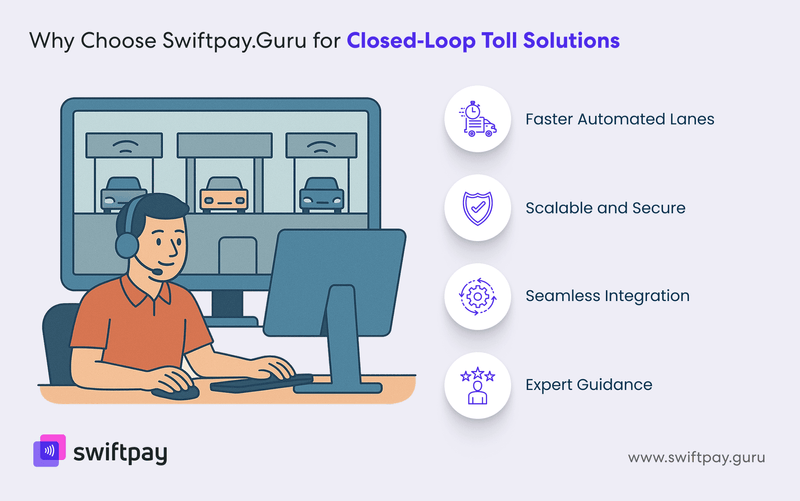
- Expert guidance: You can benefit from our experience in tolling and automated fare collection, which means you get a solution shaped by real industry knowledge.
- Seamless integration: Our team makes sure the system connects smoothly with your current setup, so you can avoid disruptions.
- Secure and scalable: Every transaction is fully protected, and the platform is built to grow with your operations so you can expand lanes, sites, or features without affecting performance or safety
With SwiftPay.Guru, you don’t just get a payment system. You get a partner who ensures every toll transaction is secure, transparent, and effortless. Moreover, we make toll collection system faster, safer, and fully future-ready, so you can focus on growing your business.
Conclusion
Toll operators face challenges like revenue loss, system downtime, and lack of payment visibility. These are real concerns, but they are not impossible to solve. You need a solution that puts you in control, delivers full transparency, and ensures long-term reliability.
SwiftPay.Guru is built with your biggest concerns in mind, thereby focusing on secure revenue, reliable operations, and full payment visibility. Our closed-loop toll payment system keeps all transactions within your network, so you always know where your revenue is going.
Additionally, the platform is designed to fit seamlessly into your operations while giving you clear insights, strong security, and flexibility to grow.
What makes us different is the way we bring together industry knowledge with practical technology. From smooth onboarding to ongoing support, we focus on making your toll collection simple, secure, and future-ready.
With SwiftPay.Guru, you gain a trusted partner who helps you handle today’s challenges while preparing for tomorrow’s growth. It is about creating toll operations that are easier to manage, more secure, and ready for the future.
If you are exploring closed-loop toll payment solutions, SwiftPay.Guru is here to guide you with a solution made especially for your business needs.
FAQs
A closed-loop toll payment system uses a dedicated wallet or account managed by the toll operator. It ensures payments remain within the operator’s ecosystem, which offers better control, faster transactions, and reduced reliance on external payment networks.
Traditional tolling accepts payments from bank cards or third-party networks, while closed-loop systems rely on operator-controlled wallets. This difference gives toll operators like you more control over transactions, reduces processing fees, and improves system reliability.
Key challenges in implementing closed-loop toll solutions include technology integration with existing infrastructure, ensuring user adoption, and addressing cybersecurity. Operators must also manage operational efficiency and handle the upfront investment required for deploying a fully functional closed-loop payment system.
Closed-loop systems provide full visibility of every payment within the operator’s network. Since no third parties are involved, revenue loss risks drop significantly, which gives toll operators like you stronger revenue control and accurate real-time data to manage collections effectively.
SwiftPay.Guru simplifies closed-loop toll adoption with a ready-to-deploy, secure, and scalable platform. We support operators through every stage, from integration to customer adoption, which ensures reduced costs and seamless transactions.
With our expertise in toll payment solutions, you gain full control over revenue, data, and system performance.
Contact us today to explore how we can help your operations succeed.
